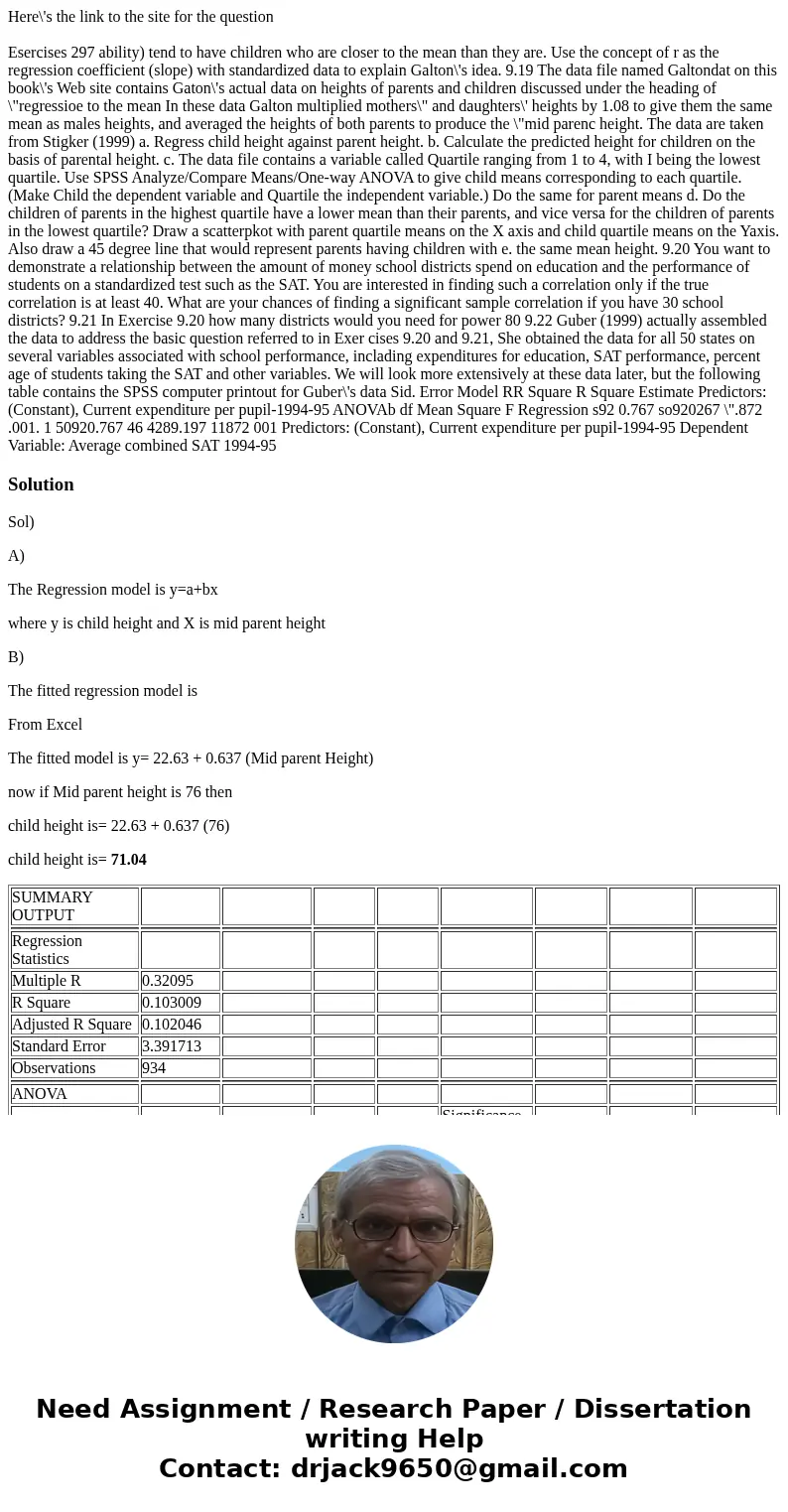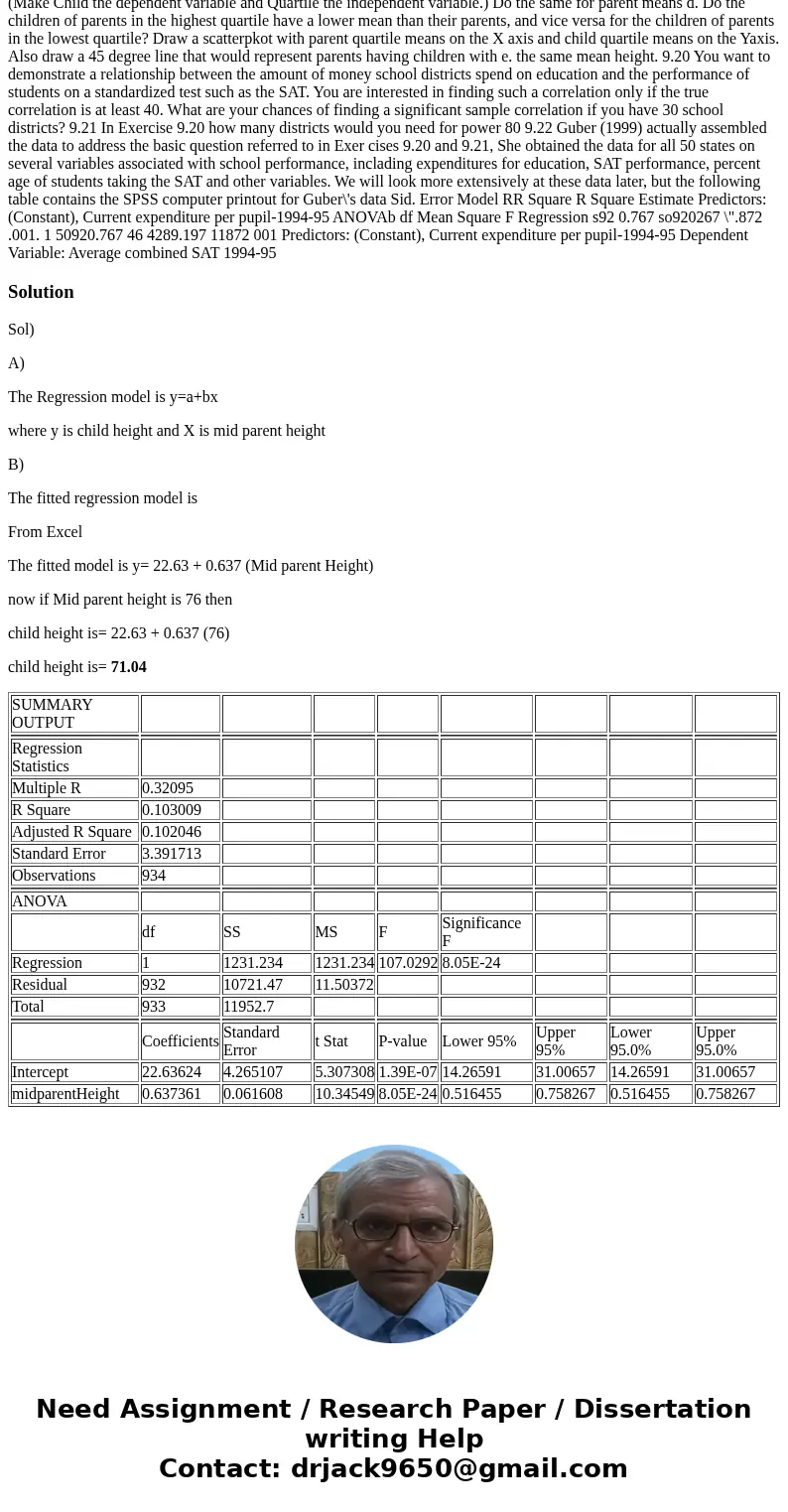Here\'s the link to the site for the question
Esercises 297 ability) tend to have children who are closer to the mean than they are. Use the concept of r as the regression coefficient (slope) with standardized data to explain Galton\'s idea. 9.19 The data file named Galtondat on this book\'s Web site contains Gaton\'s actual data on heights of parents and children discussed under the heading of \"regressioe to the mean In these data Galton multiplied mothers\" and daughters\' heights by 1.08 to give them the same mean as males heights, and averaged the heights of both parents to produce the \"mid parenc height. The data are taken from Stigker (1999) a. Regress child height against parent height. b. Calculate the predicted height for children on the basis of parental height. c. The data file contains a variable called Quartile ranging from 1 to 4, with I being the lowest quartile. Use SPSS Analyze/Compare Means/One-way ANOVA to give child means corresponding to each quartile. (Make Child the dependent variable and Quartile the independent variable.) Do the same for parent means d. Do the children of parents in the highest quartile have a lower mean than their parents, and vice versa for the children of parents in the lowest quartile? Draw a scatterpkot with parent quartile means on the X axis and child quartile means on the Yaxis. Also draw a 45 degree line that would represent parents having children with e. the same mean height. 9.20 You want to demonstrate a relationship between the amount of money school districts spend on education and the performance of students on a standardized test such as the SAT. You are interested in finding such a correlation only if the true correlation is at least 40. What are your chances of finding a significant sample correlation if you have 30 school districts? 9.21 In Exercise 9.20 how many districts would you need for power 80 9.22 Guber (1999) actually assembled the data to address the basic question referred to in Exer cises 9.20 and 9.21, She obtained the data for all 50 states on several variables associated with school performance, inclading expenditures for education, SAT performance, percent age of students taking the SAT and other variables. We will look more extensively at these data later, but the following table contains the SPSS computer printout for Guber\'s data Sid. Error Model RR Square R Square Estimate Predictors: (Constant), Current expenditure per pupil-1994-95 ANOVAb df Mean Square F Regression s92 0.767 so920267 \".872 .001. 1 50920.767 46 4289.197 11872 001 Predictors: (Constant), Current expenditure per pupil-1994-95 Dependent Variable: Average combined SAT 1994-95
Sol)
A)
The Regression model is y=a+bx
where y is child height and X is mid parent height
B)
The fitted regression model is
From Excel
The fitted model is y= 22.63 + 0.637 (Mid parent Height)
now if Mid parent height is 76 then
child height is= 22.63 + 0.637 (76)
child height is= 71.04
| SUMMARY OUTPUT | | | | | | | | |
| | | | | | | | |
| Regression Statistics | | | | | | | | |
| Multiple R | 0.32095 | | | | | | | |
| R Square | 0.103009 | | | | | | | |
| Adjusted R Square | 0.102046 | | | | | | | |
| Standard Error | 3.391713 | | | | | | | |
| Observations | 934 | | | | | | | |
| | | | | | | | |
| ANOVA | | | | | | | | |
| df | SS | MS | F | Significance F | | | |
| Regression | 1 | 1231.234 | 1231.234 | 107.0292 | 8.05E-24 | | | |
| Residual | 932 | 10721.47 | 11.50372 | | | | | |
| Total | 933 | 11952.7 | | | | | | |
| | | | | | | | |
| Coefficients | Standard Error | t Stat | P-value | Lower 95% | Upper 95% | Lower 95.0% | Upper 95.0% |
| Intercept | 22.63624 | 4.265107 | 5.307308 | 1.39E-07 | 14.26591 | 31.00657 | 14.26591 | 31.00657 |
| midparentHeight | 0.637361 | 0.061608 | 10.34549 | 8.05E-24 | 0.516455 | 0.758267 | 0.516455 | 0.758267 |


 Homework Sourse
Homework Sourse